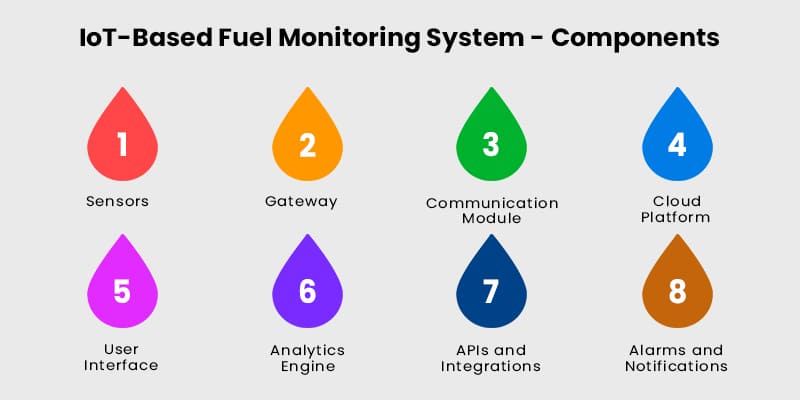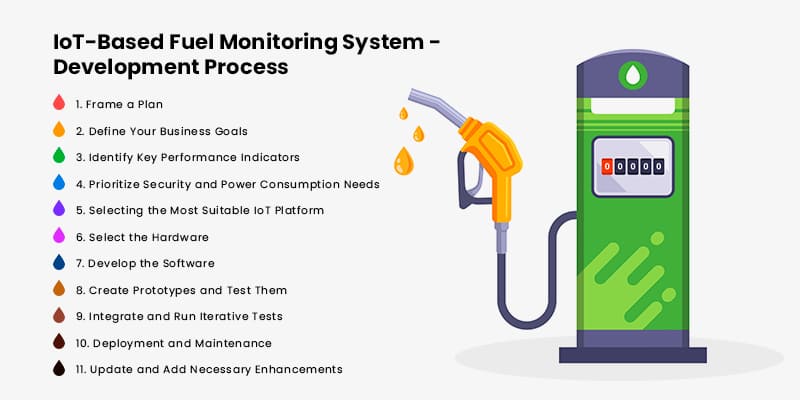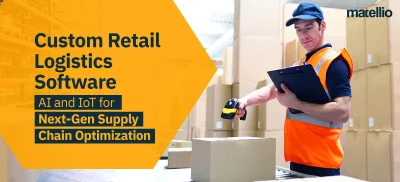
Is your transportation business incurring losses because of inefficient fuel monitoring? You’re not alone. Most industries rely heavily on fuel and face several issues due to poor fuel management. Problems like fuel theft and improper fuel consumption might occur every now and then for them as well. Do you know why? Because these businesses do not adopt an IoT-based fuel monitoring system.
Yes, as the Internet of Things continues transforming several business operations, it doesn’t leave out effective fuel monitoring. Be it regarding your storage or fuel quality, an IoT-based fuel monitoring system can manage it all for you. It empowers you with data, a critical component you can analyze to optimize fuel usage and detect potential hazards. Moreover, it’s a tool that helps you comply with the environmental guidelines necessary for fuel operators in every industry.
That’s why it is not surprising that the fuel management market will reach 707.4 million this year, as reported by MarketsandMarkets. The evaluation also marks the rising adoption of these advanced fuel management tools by multiple sectors that want to foster fuel efficiency and minimize losses. If you’re going to join this lead, dive into this guide that explores how to develop an IoT-based fuel monitoring system and select the perfect IoT development services during the process. So, stay tuned till the end to learn everything!
What is an IoT-Based Fuel Monitoring System?
It’s a tool that serves as a one-stop solution to remotely track real-time fuel levels available in storage tanks, automobiles, vehicles, or other equipment. The fuel monitoring system functions with multiple IoT sensors and internet-connected devices that help it gather real-time data and save it on a cloud platform or a central server.
So, when you use the system, you can easily analyze this data to improve your fuel consumption, watch out for fuel theft or leaks, and take other actions to maintain proper fuel management. Therefore, an IoT-based fuel monitoring system will give you full control and transparency over your fuel operations that traditional management cannot. Upscaling to this advanced management will lead you to cost reductions, diminish negative impacts on the environment on your end, and other benefits that we will discuss in the later section.
How Does an IoT-Based Fuel Monitoring System Work?
It’s better to know how a tool works to understand how it fits into your particular process. So, for starters, know that a decent IoT-based fuel monitoring system will come with a centralized dashboard showing you fuel availability, volume, and the location of your tanks in real-time. It will also have the latest and most advanced sensor devices that precisely calculate fuel quantities and fuel states in different weathers. Once you integrate the sensor devices with your company assets, the tool will present this information in consolidated analytical reports.
Using the sensors, you can automate the functions and schedules of your assets. This, in turn, will improve productivity as well as maintain an eco-friendly approach to your process. Even if you have huge fuel tanks and farms, you have control against mishaps as the system offers prompt alarms in case of leakages and anomalies, allowing you to take immediate action. Additionally, it delivers regular performance reports of your processes so that you can optimize your operations and make wise business decisions.
Thus, the IoT-based fuel monitoring system automates your entire fuel management process covering even the smallest details. Consider seeking custom enterprise software development services while creating the system to get added capabilities like efficient inventory management solutions and business-specific productivity suggestions that ultimately help you gain a competitive edge.
Components of an IoT-Based Fuel Monitoring System that offer Multiple Benefits

Multiple components of this tool work in orchestration to offer real-time fuel information, offering you the convenience to monitor and manage your fuel operations seamlessly. They components are:
Sensors
Sensors simply measure the fuel condition on various parameters like its quantity, temperature, flow, pressure, and more. According to your preference, you can ask your vendor to connect the sensors either directly with the fuel tanks or install them specifically on fuel lines. Regardless of how you take advantage of sensors, the IoT system will bring the relevant information gathered from them to you.
Gateway
It is the bridge that connects sensor devices with your cloud. It gathers sensor information and passes it over to the cloud platform. Some advanced gateways also process this data before they transmit it to the cloud. Gateways in IoT systems eliminate the need for you to process and analyze data or hire someone for data processing.
Communication Module
These are devices that help sensors interact wirelessly with the gateway. Communication modules are usually integrated into the sensors and use a wireless network. The network could be a wide-area network (LPWAN), such as LoRaWAN, NB-IoT, or a cellular network. Moreover, these modules function with wireless communication protocols like WiFi and Bluetooth. You would need the right software development company to integrate the appropriate communication modules in your IoT system. This will allow you to customize your real-time data preferences and enhances remote control by delivering data from multiple sources.
Cloud Platform
It’s a critical component of the IoT-based fuel monitoring system that stores and processes the information that the gateway sends from the sensors. Having a cloud platform enables you to take multiple actions regarding relevant information, such as storing, accessing, sharing, and more. It’s better to look for a development partner who is an expert in cloud integration services so that you can customize your IoT system’s infrastructure according to your business needs.
User Interface
It’s the face of your system that enables you to access and visualize the fuel monitoring system data from anywhere at any time. You give commands to the system to adjust fuel levels, view fuel consumption, set emergency alarms, and generate and seek reports through the system’s interface. Ask your development partner to infuse intuitiveness into the interface along with other relevant features necessary for your business.
Analytics Engine
Here is where all the final data and insights origination takes place. The analytics engine employs machine learning algorithms and other techniques to recognize data patterns and anomalies. Ensuring that you use a strong analytics engine built by expert software professionals will help you streamline your fuel operations, leading you to optimize fuel consumption, reduce expenses, and boost efficiency.
APIs and Integrations
The APIs and integrations used in an IoT-based fuel monitoring system facilitate communication between your system with external devices and systems. For instance, you can integrate it with your fleet management system and easily track the fuel levels of vehicles present in your particular fleet. Similarly, your development partner can integrate it with your ERP system to track your overall fuel expenditure and generate invoices. However, you should work with experienced software engineers who understand your integration needs and incorporate the relevant APIs for your smooth fuel operations.
Alarms and Notifications
You can ask your cloud provider to configure your system to buzz alarms and send notifications right before your tanks run out of fuel or if there are sudden fuel leakages. It’s a helpful component of the IoT fuel monitoring system that allows you to take prompt action during unpredictable situations and issues. Unlike traditional systems, IoT saves you from unfortunate instances by notifying you about the potential bottlenecks before.
Also Read- IoT Consulting Services: Everything You Need to Know
Developing An IoT-Based Fuel Monitoring System

As a business, you need to consider a plethora of factors before you deploy and integrate anything new with your existing process. The same goes for IoT-based fuel monitoring system development. The key elements and steps you should consider here are:
Frame a Plan
First things first, curate a plan on how you will attempt designing and developing your IoT-based fuel monitoring system. Here, you have to think about your modus operandi, which stakeholders will contribute, what parameters of development will be critical and which ones are not, and so on.
Define Your Business Goals
After you have the plan, align it with your business objectives. Your goals could include optimizing fuel efficiency, lowering fuel consumption, detecting leaks and theft, and more. Whatever goals you set, ensure they are business-specific and clearly defined for the design and development teams to implement.
Identify Key Performance Indicators (KPIs)
Once you set your goals clearly, identify your KPIs to measure the progress you will make using the tool. These KPIs are parameters for companies to help them improve their process. For fuel management, you can set KPIs like-
- Daily fuel consumption
- Instances of fuel leakages
- The number of theft threats, etc.
Prioritize Security and Power Consumption Needs
This is a critical step, and the responsibility to ensure this actually rests on your shoulders. To prioritize security, you can check if the devices of your IoT-based fuel monitoring system are immune from unauthorized access, if your storing methods are reliable, etc. Similarly, select devices and sensors that require less power for battery life extension and do not require maintenance often to ensure profits and lower carbon footprint. Managing these batteries is critical for the proper functioning of your IoT devices.
Selecting the Most Suitable IoT Platform
During this step, you must ensure your selected IoT platform is reliable, secure, and scalable. You can seek IoT consulting services to learn about IoT platforms in detail from IoT experts. Doing this will help you save time you would otherwise spend researching and analyzing different IoT platforms.
Also Read- IoT Product Development: Use Cases and Development Process
Select the Hardware
Select high-quality hardware components for the reliability and performance of your IoT fuel monitoring system. Hardware involves sensor devices, gateways, and other vital elements that together make up your IoT platform, along with the software.
Develop the Software
Software development includes both design and development of your IoT app with which you will interact. You should select a reliable software development partner like Matellio that has experience and expertise in developing IoT software that can seamlessly gather and analyze data from sensors and other platform components, transfer it to the cloud securely, and display it on your app’s interface. Moreover, ensure they work on enterprise solutions to maintain the scalability and flexibility of your platform.
Create Prototypes and Test Them
A decent development partner will offer various prototypes to let you analyze which one works best with your existing process. After creating prototypes, you shortlist the best ones and run tests to select the perfect one. Testing gives you the satisfaction that your selected prototype functions as intended. To ensure this, you can create physical replicas of your IoT model and test it in a simulation.
Integrate and Run Iterative Tests
Once you complete the hardware and software development, it’s time to integrate all the pieces you’ve created. So, connect the hardware with the software to finally form your unified functional IoT-based fuel monitoring system. Then, run tests to check they work together in sync. Running iterative tests will ensure that your system fulfills your goals and the defined KPIs you set in the planning stage.
Deployment and Maintenance
After you run tests with your development partner are become satisfied with your platform, you’re all set to deploy your IoT-based fuel monitoring system. Work with your development to prepare for deployment and run your system before making it available for your company. Then, train the key stakeholders who will directly work and use the system. After this step, all you have to do is oversee if proper maintenance is taking place to ensure the security and performance of your system.
Update and Add Necessary Enhancements
Understand that with a new technology integrated into your system, you should update it to ensure you get the best out of it for your business. The updates could include modification of hardware and software elements or adding new features. Following these upgrades will help optimize your system performance and maintain security.
Why Choose Matellio for Developing Your IoT-Based Fuel Monitoring System?
Matellio specializes in comprehensive digital transformation services for various business domains. Our team is well-equipped with the ins and outs of the latest technologies and has a record of delivering successful IoT, ML, and AI-based projects.
With our experience and expertise, you can be stress-free while creating your IoT-based fuel monitoring system development. Our IoT developers and testers offer high-quality services to develop, test, deploy, and maintain IoT systems. They work with a client-first approach, communicating with them thoroughly throughout the project initiation to completion. Additionally, we also serve our clients with prompt and satisfactory customer service they need at various phases of development.





